The Detrimental Impact of Black Money on the Indian Economy
VerifiedAdded on 2021/06/16
|18
|4228
|61
Report
AI Summary
This report examines the multifaceted impact of black money on the Indian economy. It begins by defining black money and outlining its origins, including complex tax structures, corruption, and illegal activities. The report then delves into the present status of black money in India, highlighting the vast sums involved and the government's response. A significant portion of the report analyzes the detrimental effects of black money on various aspects of the Indian economy, such as the fiscal system, public services, income inequality, national income, resource allocation, and criminal activities. It also explores how black money contributes to inflation and the underestimation of GDP. Finally, the report identifies measures taken by the Indian government to curb black money, offering a comprehensive overview of the issue and its implications.

Running head: IMPACT OF BLACK MONEY ON THE INDIAN ECONOMY
IMPACT OF BLACK MONEY ON THE INDIAN ECONOMY
Name of the Student
Name of the University
Author’s Note
IMPACT OF BLACK MONEY ON THE INDIAN ECONOMY
Name of the Student
Name of the University
Author’s Note
Paraphrase This Document
Need a fresh take? Get an instant paraphrase of this document with our AI Paraphraser
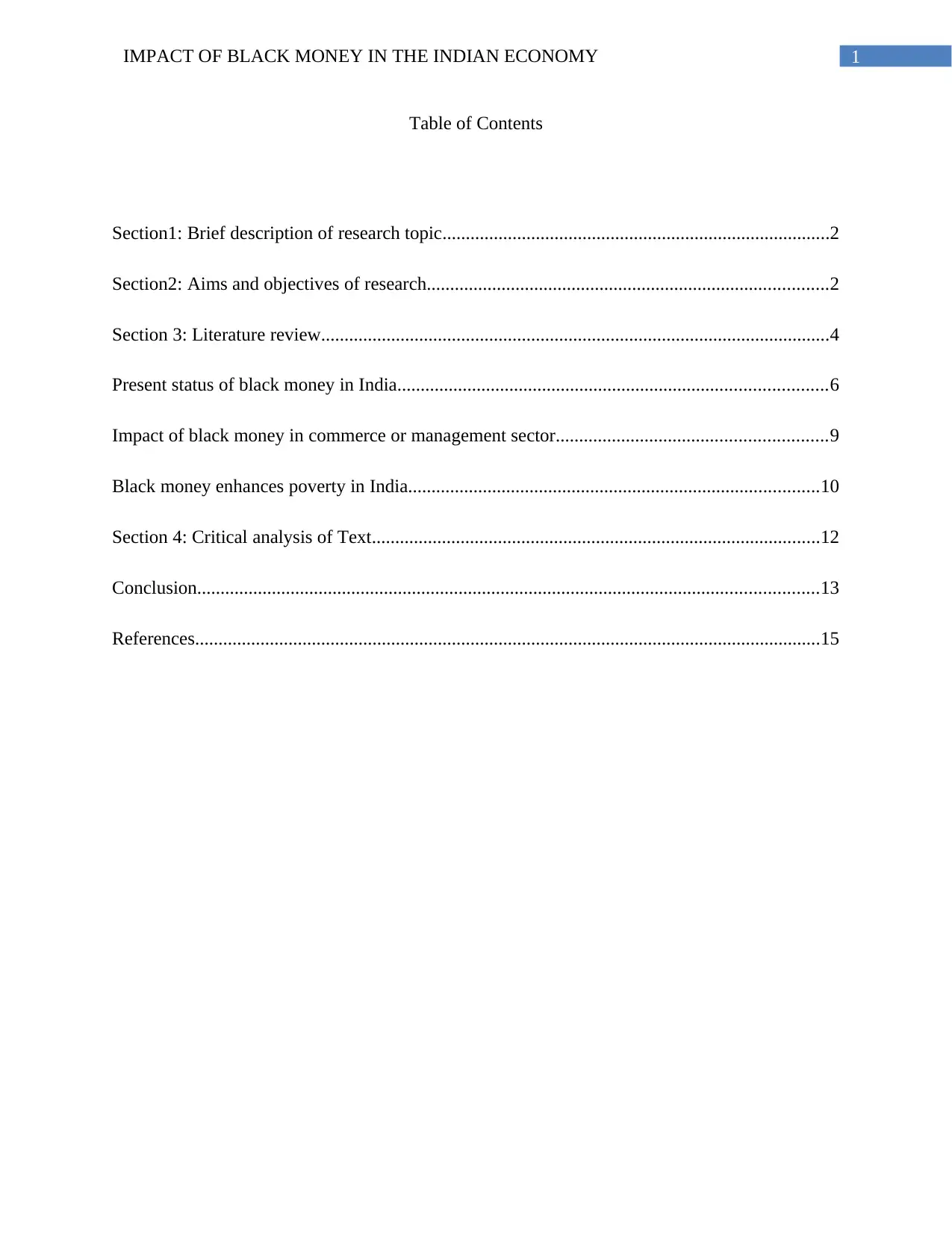
1IMPACT OF BLACK MONEY IN THE INDIAN ECONOMY
Table of Contents
Section1: Brief description of research topic...................................................................................2
Section2: Aims and objectives of research......................................................................................2
Section 3: Literature review.............................................................................................................4
Present status of black money in India............................................................................................6
Impact of black money in commerce or management sector..........................................................9
Black money enhances poverty in India........................................................................................10
Section 4: Critical analysis of Text................................................................................................12
Conclusion.....................................................................................................................................13
References......................................................................................................................................15
Table of Contents
Section1: Brief description of research topic...................................................................................2
Section2: Aims and objectives of research......................................................................................2
Section 3: Literature review.............................................................................................................4
Present status of black money in India............................................................................................6
Impact of black money in commerce or management sector..........................................................9
Black money enhances poverty in India........................................................................................10
Section 4: Critical analysis of Text................................................................................................12
Conclusion.....................................................................................................................................13
References......................................................................................................................................15
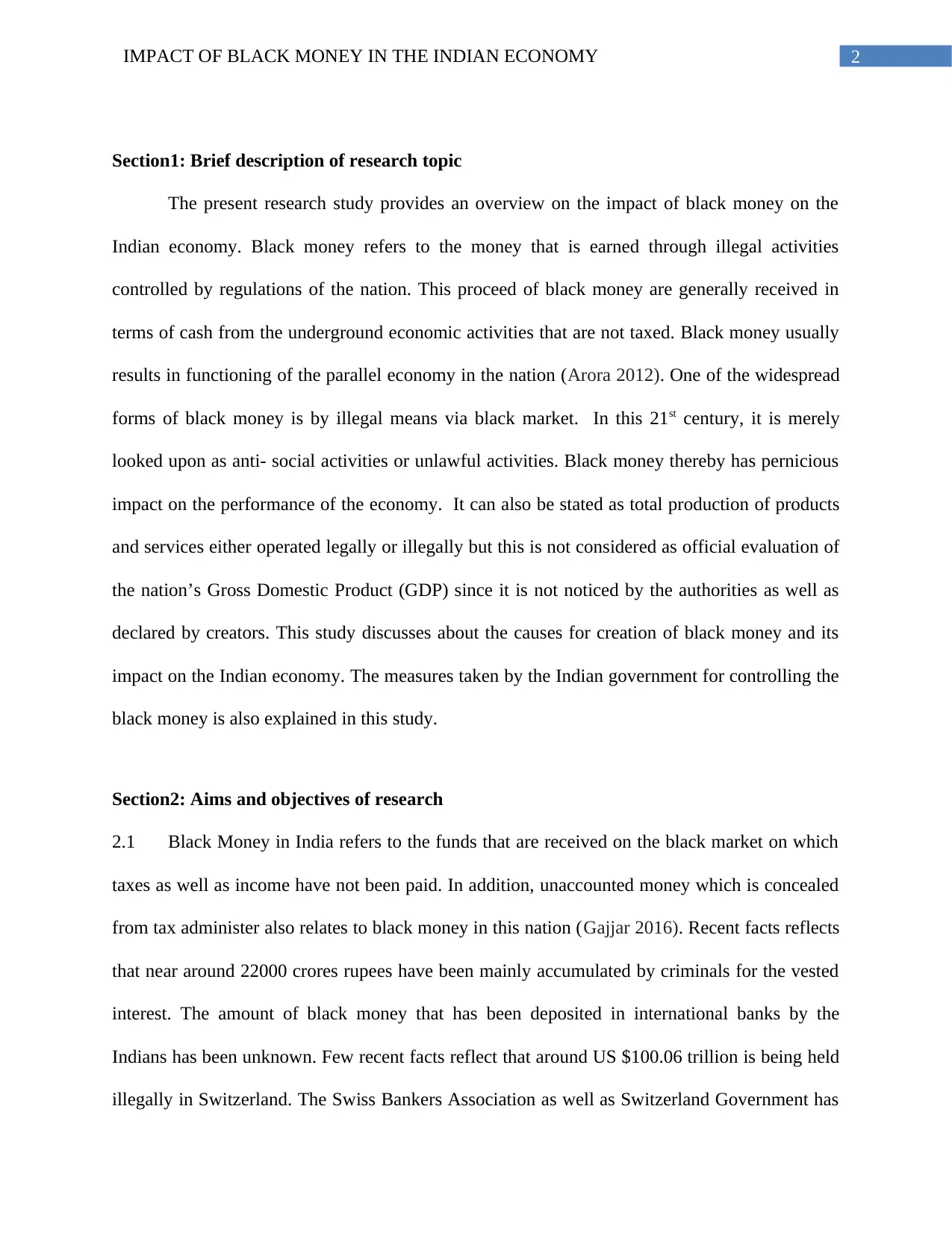
2IMPACT OF BLACK MONEY IN THE INDIAN ECONOMY
Section1: Brief description of research topic
The present research study provides an overview on the impact of black money on the
Indian economy. Black money refers to the money that is earned through illegal activities
controlled by regulations of the nation. This proceed of black money are generally received in
terms of cash from the underground economic activities that are not taxed. Black money usually
results in functioning of the parallel economy in the nation (Arora 2012). One of the widespread
forms of black money is by illegal means via black market. In this 21st century, it is merely
looked upon as anti- social activities or unlawful activities. Black money thereby has pernicious
impact on the performance of the economy. It can also be stated as total production of products
and services either operated legally or illegally but this is not considered as official evaluation of
the nation’s Gross Domestic Product (GDP) since it is not noticed by the authorities as well as
declared by creators. This study discusses about the causes for creation of black money and its
impact on the Indian economy. The measures taken by the Indian government for controlling the
black money is also explained in this study.
Section2: Aims and objectives of research
2.1 Black Money in India refers to the funds that are received on the black market on which
taxes as well as income have not been paid. In addition, unaccounted money which is concealed
from tax administer also relates to black money in this nation (Gajjar 2016). Recent facts reflects
that near around 22000 crores rupees have been mainly accumulated by criminals for the vested
interest. The amount of black money that has been deposited in international banks by the
Indians has been unknown. Few recent facts reflect that around US $100.06 trillion is being held
illegally in Switzerland. The Swiss Bankers Association as well as Switzerland Government has
Section1: Brief description of research topic
The present research study provides an overview on the impact of black money on the
Indian economy. Black money refers to the money that is earned through illegal activities
controlled by regulations of the nation. This proceed of black money are generally received in
terms of cash from the underground economic activities that are not taxed. Black money usually
results in functioning of the parallel economy in the nation (Arora 2012). One of the widespread
forms of black money is by illegal means via black market. In this 21st century, it is merely
looked upon as anti- social activities or unlawful activities. Black money thereby has pernicious
impact on the performance of the economy. It can also be stated as total production of products
and services either operated legally or illegally but this is not considered as official evaluation of
the nation’s Gross Domestic Product (GDP) since it is not noticed by the authorities as well as
declared by creators. This study discusses about the causes for creation of black money and its
impact on the Indian economy. The measures taken by the Indian government for controlling the
black money is also explained in this study.
Section2: Aims and objectives of research
2.1 Black Money in India refers to the funds that are received on the black market on which
taxes as well as income have not been paid. In addition, unaccounted money which is concealed
from tax administer also relates to black money in this nation (Gajjar 2016). Recent facts reflects
that near around 22000 crores rupees have been mainly accumulated by criminals for the vested
interest. The amount of black money that has been deposited in international banks by the
Indians has been unknown. Few recent facts reflect that around US $100.06 trillion is being held
illegally in Switzerland. The Swiss Bankers Association as well as Switzerland Government has
⊘ This is a preview!⊘
Do you want full access?
Subscribe today to unlock all pages.

Trusted by 1+ million students worldwide
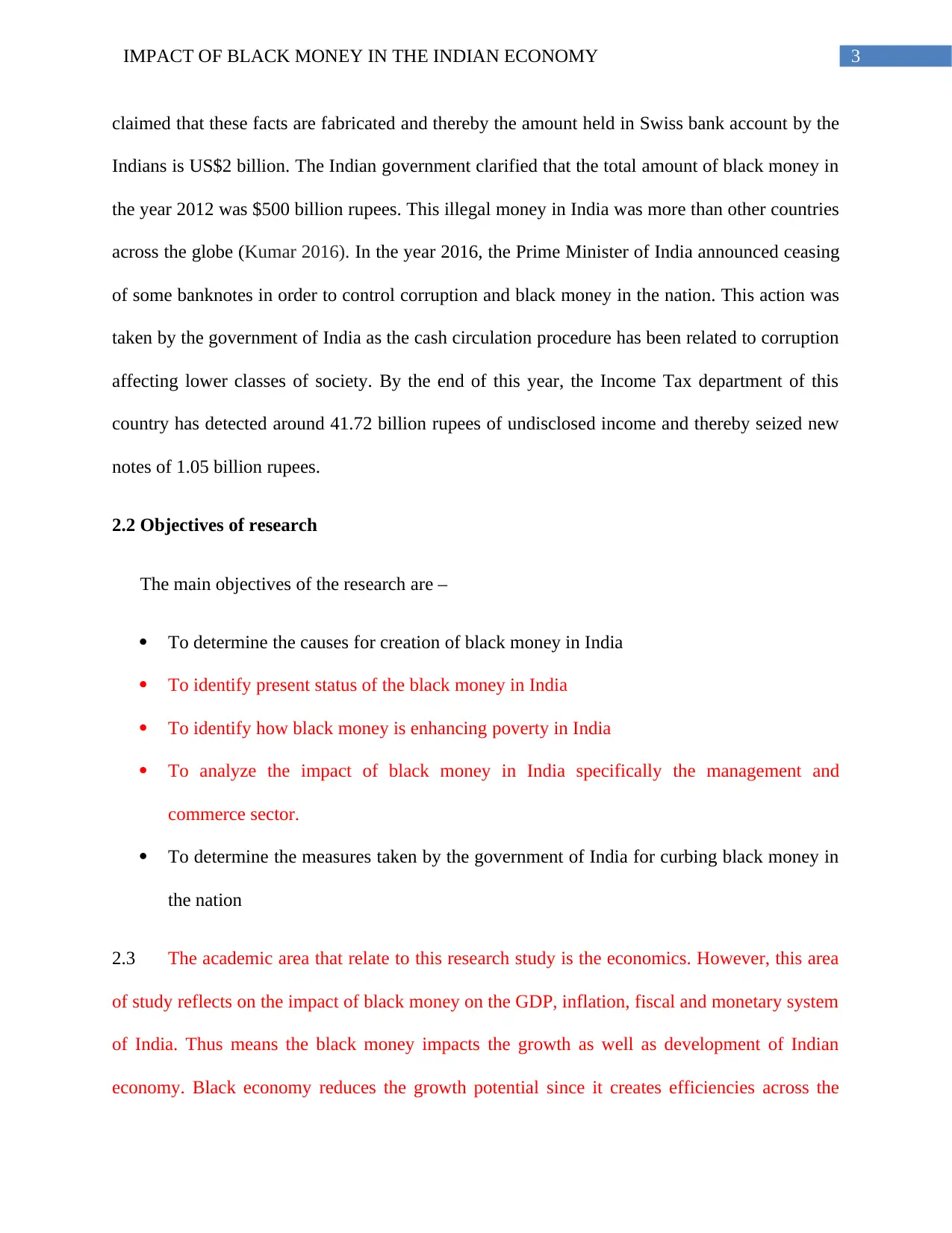
3IMPACT OF BLACK MONEY IN THE INDIAN ECONOMY
claimed that these facts are fabricated and thereby the amount held in Swiss bank account by the
Indians is US$2 billion. The Indian government clarified that the total amount of black money in
the year 2012 was $500 billion rupees. This illegal money in India was more than other countries
across the globe (Kumar 2016). In the year 2016, the Prime Minister of India announced ceasing
of some banknotes in order to control corruption and black money in the nation. This action was
taken by the government of India as the cash circulation procedure has been related to corruption
affecting lower classes of society. By the end of this year, the Income Tax department of this
country has detected around 41.72 billion rupees of undisclosed income and thereby seized new
notes of 1.05 billion rupees.
2.2 Objectives of research
The main objectives of the research are –
To determine the causes for creation of black money in India
To identify present status of the black money in India
To identify how black money is enhancing poverty in India
To analyze the impact of black money in India specifically the management and
commerce sector.
To determine the measures taken by the government of India for curbing black money in
the nation
2.3 The academic area that relate to this research study is the economics. However, this area
of study reflects on the impact of black money on the GDP, inflation, fiscal and monetary system
of India. Thus means the black money impacts the growth as well as development of Indian
economy. Black economy reduces the growth potential since it creates efficiencies across the
claimed that these facts are fabricated and thereby the amount held in Swiss bank account by the
Indians is US$2 billion. The Indian government clarified that the total amount of black money in
the year 2012 was $500 billion rupees. This illegal money in India was more than other countries
across the globe (Kumar 2016). In the year 2016, the Prime Minister of India announced ceasing
of some banknotes in order to control corruption and black money in the nation. This action was
taken by the government of India as the cash circulation procedure has been related to corruption
affecting lower classes of society. By the end of this year, the Income Tax department of this
country has detected around 41.72 billion rupees of undisclosed income and thereby seized new
notes of 1.05 billion rupees.
2.2 Objectives of research
The main objectives of the research are –
To determine the causes for creation of black money in India
To identify present status of the black money in India
To identify how black money is enhancing poverty in India
To analyze the impact of black money in India specifically the management and
commerce sector.
To determine the measures taken by the government of India for curbing black money in
the nation
2.3 The academic area that relate to this research study is the economics. However, this area
of study reflects on the impact of black money on the GDP, inflation, fiscal and monetary system
of India. Thus means the black money impacts the growth as well as development of Indian
economy. Black economy reduces the growth potential since it creates efficiencies across the
Paraphrase This Document
Need a fresh take? Get an instant paraphrase of this document with our AI Paraphraser
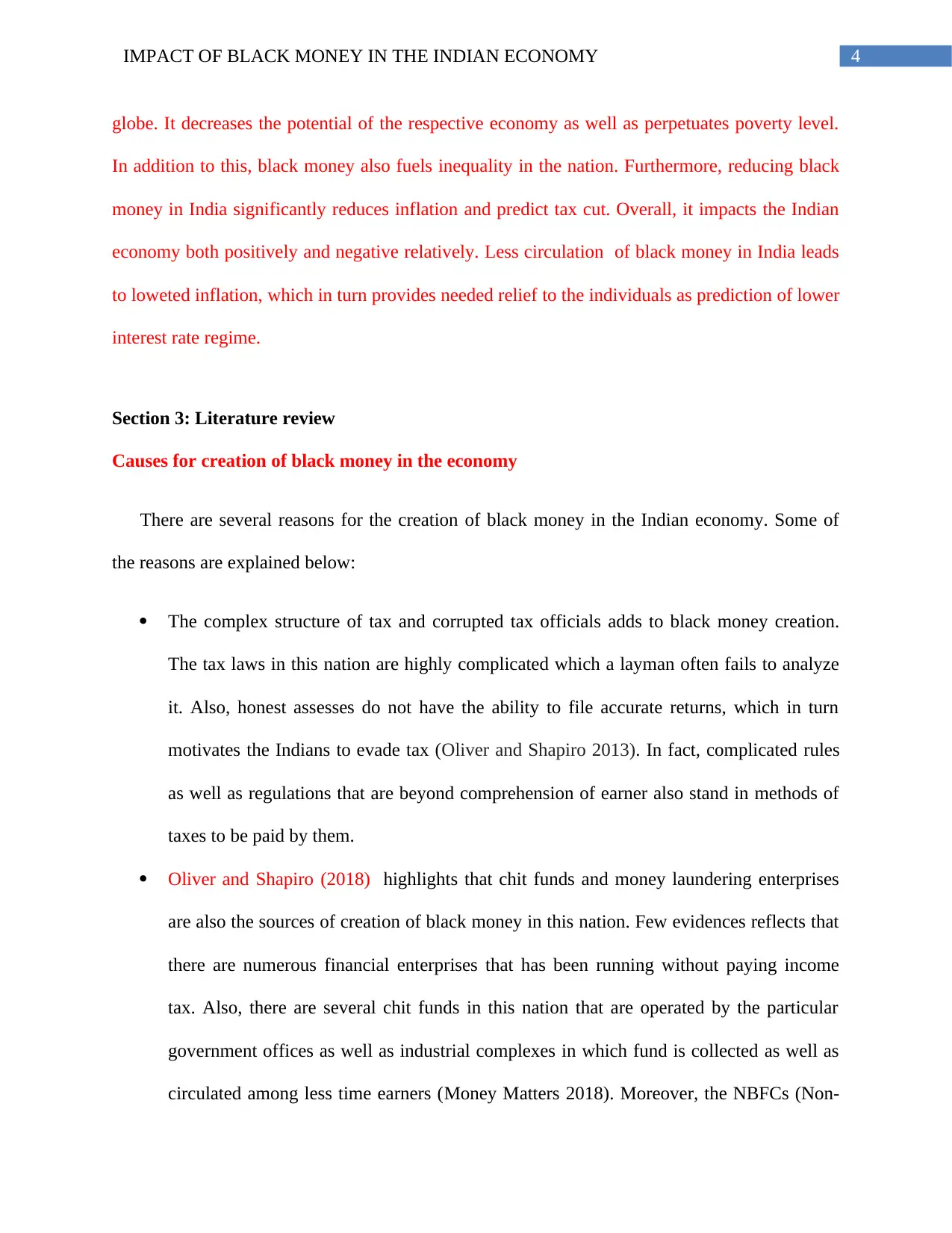
4IMPACT OF BLACK MONEY IN THE INDIAN ECONOMY
globe. It decreases the potential of the respective economy as well as perpetuates poverty level.
In addition to this, black money also fuels inequality in the nation. Furthermore, reducing black
money in India significantly reduces inflation and predict tax cut. Overall, it impacts the Indian
economy both positively and negative relatively. Less circulation of black money in India leads
to loweted inflation, which in turn provides needed relief to the individuals as prediction of lower
interest rate regime.
Section 3: Literature review
Causes for creation of black money in the economy
There are several reasons for the creation of black money in the Indian economy. Some of
the reasons are explained below:
The complex structure of tax and corrupted tax officials adds to black money creation.
The tax laws in this nation are highly complicated which a layman often fails to analyze
it. Also, honest assesses do not have the ability to file accurate returns, which in turn
motivates the Indians to evade tax (Oliver and Shapiro 2013). In fact, complicated rules
as well as regulations that are beyond comprehension of earner also stand in methods of
taxes to be paid by them.
Oliver and Shapiro (2018) highlights that chit funds and money laundering enterprises
are also the sources of creation of black money in this nation. Few evidences reflects that
there are numerous financial enterprises that has been running without paying income
tax. Also, there are several chit funds in this nation that are operated by the particular
government offices as well as industrial complexes in which fund is collected as well as
circulated among less time earners (Money Matters 2018). Moreover, the NBFCs (Non-
globe. It decreases the potential of the respective economy as well as perpetuates poverty level.
In addition to this, black money also fuels inequality in the nation. Furthermore, reducing black
money in India significantly reduces inflation and predict tax cut. Overall, it impacts the Indian
economy both positively and negative relatively. Less circulation of black money in India leads
to loweted inflation, which in turn provides needed relief to the individuals as prediction of lower
interest rate regime.
Section 3: Literature review
Causes for creation of black money in the economy
There are several reasons for the creation of black money in the Indian economy. Some of
the reasons are explained below:
The complex structure of tax and corrupted tax officials adds to black money creation.
The tax laws in this nation are highly complicated which a layman often fails to analyze
it. Also, honest assesses do not have the ability to file accurate returns, which in turn
motivates the Indians to evade tax (Oliver and Shapiro 2013). In fact, complicated rules
as well as regulations that are beyond comprehension of earner also stand in methods of
taxes to be paid by them.
Oliver and Shapiro (2018) highlights that chit funds and money laundering enterprises
are also the sources of creation of black money in this nation. Few evidences reflects that
there are numerous financial enterprises that has been running without paying income
tax. Also, there are several chit funds in this nation that are operated by the particular
government offices as well as industrial complexes in which fund is collected as well as
circulated among less time earners (Money Matters 2018). Moreover, the NBFCs (Non-

5IMPACT OF BLACK MONEY IN THE INDIAN ECONOMY
banking financial companies) operations have also become highly uncontrolled over the
years, which in turn also create black money in this nation.
According to Gajjar (2016), big industrial houses, politicians, big contractors and
bureaucrats collude with one another in large transactions and also indulge in dealings
while issuing licenses. However, the brokers are often involved in heavy fees transactions
through illegal banking channels.
The election procedure is another cause of black money creation in this nation. The
election campaigns that are run by candidates usually generates huge amount of black
money in this country. Tiwari and Khan (2012) highlights that large business houses
mainly donate huge black money to these political parties with the main intention to tame
political leadership in order to derive advantage by influencing their policy decisions.
Huge donations to the educational institutions for admissions are also another reason of
circulation of black money in the nation. Thomas (2016) clarifies that the transactions of
black money also take place in setting as well as revealing of question papers in order to
ascertain that few students would pass via unfair means. Hence, it also leads to bad
performance of educational institutions.
Another factor that is responsible for huge increase in black money in India is
transactions in urban real estate. It has been found by the authorities that the builders
often move in illegal activities while making transactions in real estate.
Privatization also opened up new area to bureaucrats and private sectors for creating
black money. However, several scams also came into light in order to make black money
through privatization.
banking financial companies) operations have also become highly uncontrolled over the
years, which in turn also create black money in this nation.
According to Gajjar (2016), big industrial houses, politicians, big contractors and
bureaucrats collude with one another in large transactions and also indulge in dealings
while issuing licenses. However, the brokers are often involved in heavy fees transactions
through illegal banking channels.
The election procedure is another cause of black money creation in this nation. The
election campaigns that are run by candidates usually generates huge amount of black
money in this country. Tiwari and Khan (2012) highlights that large business houses
mainly donate huge black money to these political parties with the main intention to tame
political leadership in order to derive advantage by influencing their policy decisions.
Huge donations to the educational institutions for admissions are also another reason of
circulation of black money in the nation. Thomas (2016) clarifies that the transactions of
black money also take place in setting as well as revealing of question papers in order to
ascertain that few students would pass via unfair means. Hence, it also leads to bad
performance of educational institutions.
Another factor that is responsible for huge increase in black money in India is
transactions in urban real estate. It has been found by the authorities that the builders
often move in illegal activities while making transactions in real estate.
Privatization also opened up new area to bureaucrats and private sectors for creating
black money. However, several scams also came into light in order to make black money
through privatization.
⊘ This is a preview!⊘
Do you want full access?
Subscribe today to unlock all pages.

Trusted by 1+ million students worldwide
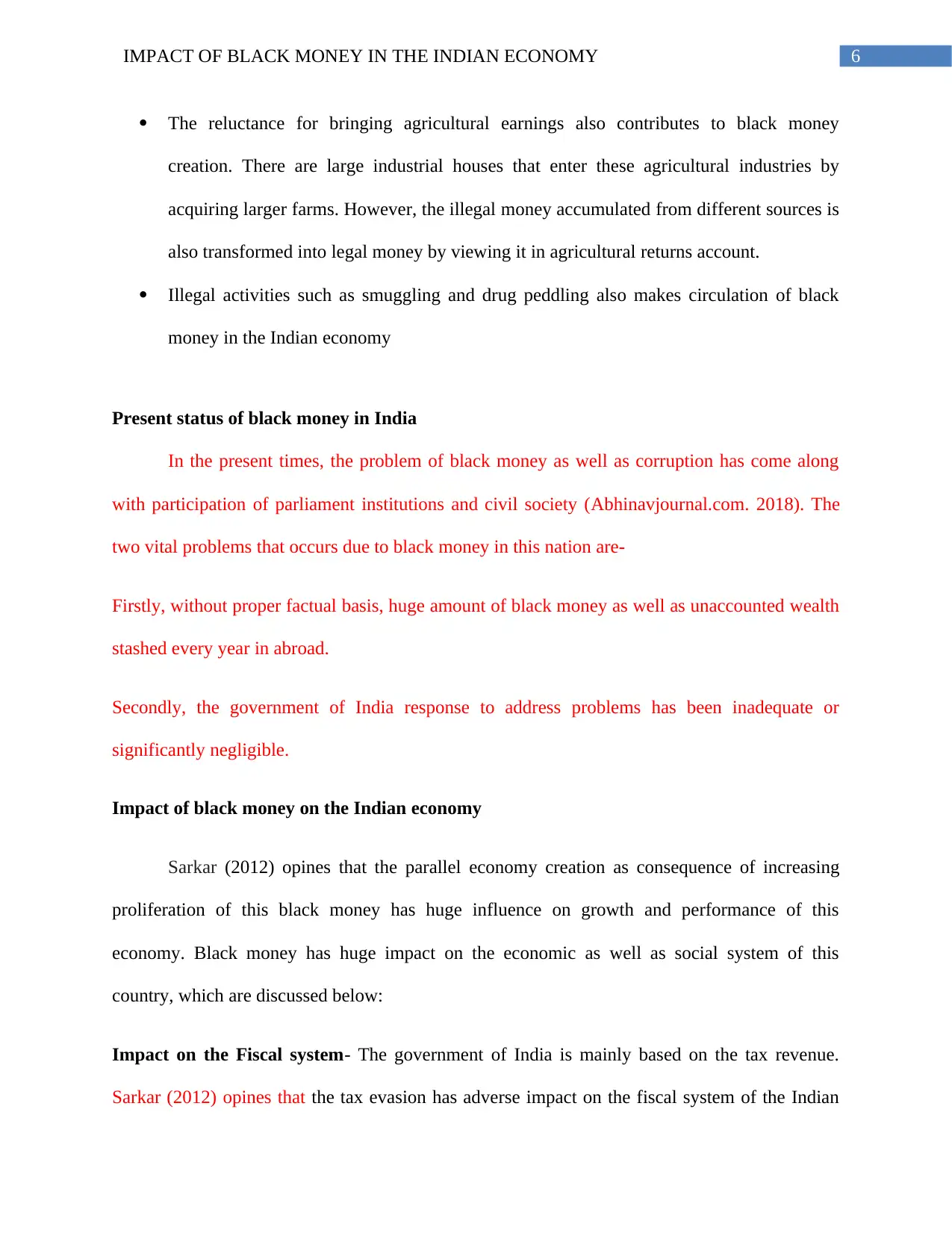
6IMPACT OF BLACK MONEY IN THE INDIAN ECONOMY
The reluctance for bringing agricultural earnings also contributes to black money
creation. There are large industrial houses that enter these agricultural industries by
acquiring larger farms. However, the illegal money accumulated from different sources is
also transformed into legal money by viewing it in agricultural returns account.
Illegal activities such as smuggling and drug peddling also makes circulation of black
money in the Indian economy
Present status of black money in India
In the present times, the problem of black money as well as corruption has come along
with participation of parliament institutions and civil society (Abhinavjournal.com. 2018). The
two vital problems that occurs due to black money in this nation are-
Firstly, without proper factual basis, huge amount of black money as well as unaccounted wealth
stashed every year in abroad.
Secondly, the government of India response to address problems has been inadequate or
significantly negligible.
Impact of black money on the Indian economy
Sarkar (2012) opines that the parallel economy creation as consequence of increasing
proliferation of this black money has huge influence on growth and performance of this
economy. Black money has huge impact on the economic as well as social system of this
country, which are discussed below:
Impact on the Fiscal system- The government of India is mainly based on the tax revenue.
Sarkar (2012) opines that the tax evasion has adverse impact on the fiscal system of the Indian
The reluctance for bringing agricultural earnings also contributes to black money
creation. There are large industrial houses that enter these agricultural industries by
acquiring larger farms. However, the illegal money accumulated from different sources is
also transformed into legal money by viewing it in agricultural returns account.
Illegal activities such as smuggling and drug peddling also makes circulation of black
money in the Indian economy
Present status of black money in India
In the present times, the problem of black money as well as corruption has come along
with participation of parliament institutions and civil society (Abhinavjournal.com. 2018). The
two vital problems that occurs due to black money in this nation are-
Firstly, without proper factual basis, huge amount of black money as well as unaccounted wealth
stashed every year in abroad.
Secondly, the government of India response to address problems has been inadequate or
significantly negligible.
Impact of black money on the Indian economy
Sarkar (2012) opines that the parallel economy creation as consequence of increasing
proliferation of this black money has huge influence on growth and performance of this
economy. Black money has huge impact on the economic as well as social system of this
country, which are discussed below:
Impact on the Fiscal system- The government of India is mainly based on the tax revenue.
Sarkar (2012) opines that the tax evasion has adverse impact on the fiscal system of the Indian
Paraphrase This Document
Need a fresh take? Get an instant paraphrase of this document with our AI Paraphraser
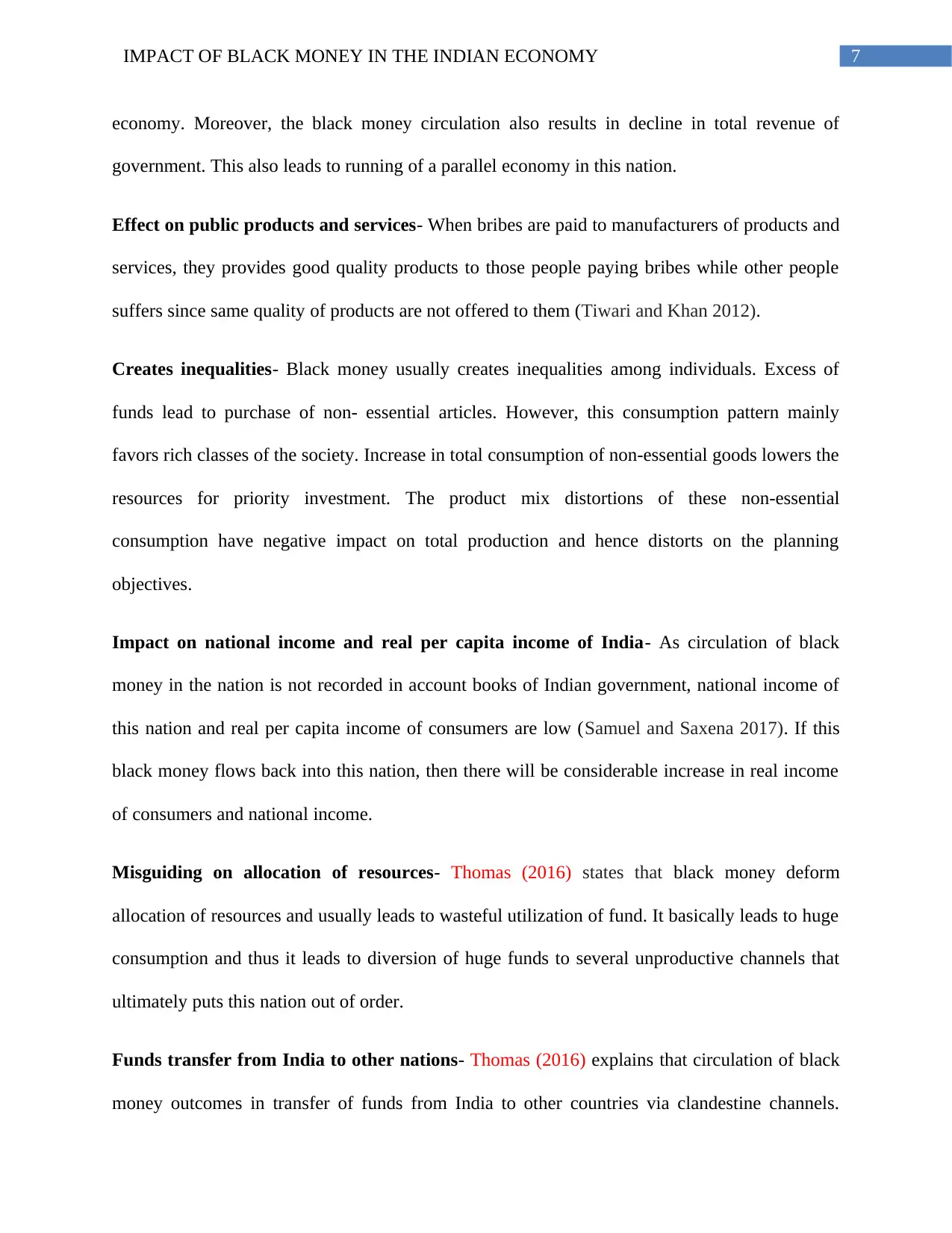
7IMPACT OF BLACK MONEY IN THE INDIAN ECONOMY
economy. Moreover, the black money circulation also results in decline in total revenue of
government. This also leads to running of a parallel economy in this nation.
Effect on public products and services- When bribes are paid to manufacturers of products and
services, they provides good quality products to those people paying bribes while other people
suffers since same quality of products are not offered to them (Tiwari and Khan 2012).
Creates inequalities- Black money usually creates inequalities among individuals. Excess of
funds lead to purchase of non- essential articles. However, this consumption pattern mainly
favors rich classes of the society. Increase in total consumption of non-essential goods lowers the
resources for priority investment. The product mix distortions of these non-essential
consumption have negative impact on total production and hence distorts on the planning
objectives.
Impact on national income and real per capita income of India- As circulation of black
money in the nation is not recorded in account books of Indian government, national income of
this nation and real per capita income of consumers are low (Samuel and Saxena 2017). If this
black money flows back into this nation, then there will be considerable increase in real income
of consumers and national income.
Misguiding on allocation of resources- Thomas (2016) states that black money deform
allocation of resources and usually leads to wasteful utilization of fund. It basically leads to huge
consumption and thus it leads to diversion of huge funds to several unproductive channels that
ultimately puts this nation out of order.
Funds transfer from India to other nations- Thomas (2016) explains that circulation of black
money outcomes in transfer of funds from India to other countries via clandestine channels.
economy. Moreover, the black money circulation also results in decline in total revenue of
government. This also leads to running of a parallel economy in this nation.
Effect on public products and services- When bribes are paid to manufacturers of products and
services, they provides good quality products to those people paying bribes while other people
suffers since same quality of products are not offered to them (Tiwari and Khan 2012).
Creates inequalities- Black money usually creates inequalities among individuals. Excess of
funds lead to purchase of non- essential articles. However, this consumption pattern mainly
favors rich classes of the society. Increase in total consumption of non-essential goods lowers the
resources for priority investment. The product mix distortions of these non-essential
consumption have negative impact on total production and hence distorts on the planning
objectives.
Impact on national income and real per capita income of India- As circulation of black
money in the nation is not recorded in account books of Indian government, national income of
this nation and real per capita income of consumers are low (Samuel and Saxena 2017). If this
black money flows back into this nation, then there will be considerable increase in real income
of consumers and national income.
Misguiding on allocation of resources- Thomas (2016) states that black money deform
allocation of resources and usually leads to wasteful utilization of fund. It basically leads to huge
consumption and thus it leads to diversion of huge funds to several unproductive channels that
ultimately puts this nation out of order.
Funds transfer from India to other nations- Thomas (2016) explains that circulation of black
money outcomes in transfer of funds from India to other countries via clandestine channels.
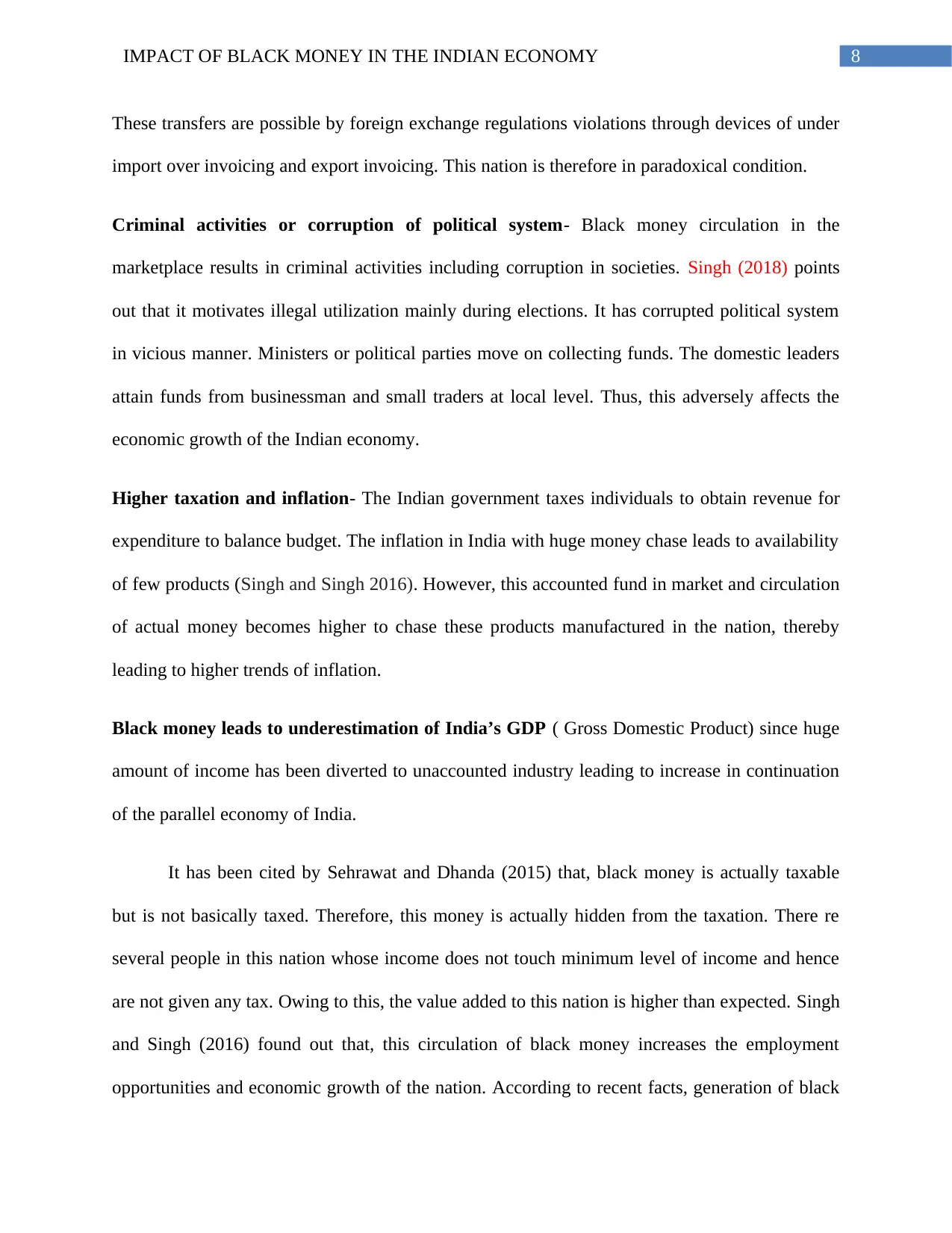
8IMPACT OF BLACK MONEY IN THE INDIAN ECONOMY
These transfers are possible by foreign exchange regulations violations through devices of under
import over invoicing and export invoicing. This nation is therefore in paradoxical condition.
Criminal activities or corruption of political system- Black money circulation in the
marketplace results in criminal activities including corruption in societies. Singh (2018) points
out that it motivates illegal utilization mainly during elections. It has corrupted political system
in vicious manner. Ministers or political parties move on collecting funds. The domestic leaders
attain funds from businessman and small traders at local level. Thus, this adversely affects the
economic growth of the Indian economy.
Higher taxation and inflation- The Indian government taxes individuals to obtain revenue for
expenditure to balance budget. The inflation in India with huge money chase leads to availability
of few products (Singh and Singh 2016). However, this accounted fund in market and circulation
of actual money becomes higher to chase these products manufactured in the nation, thereby
leading to higher trends of inflation.
Black money leads to underestimation of India’s GDP ( Gross Domestic Product) since huge
amount of income has been diverted to unaccounted industry leading to increase in continuation
of the parallel economy of India.
It has been cited by Sehrawat and Dhanda (2015) that, black money is actually taxable
but is not basically taxed. Therefore, this money is actually hidden from the taxation. There re
several people in this nation whose income does not touch minimum level of income and hence
are not given any tax. Owing to this, the value added to this nation is higher than expected. Singh
and Singh (2016) found out that, this circulation of black money increases the employment
opportunities and economic growth of the nation. According to recent facts, generation of black
These transfers are possible by foreign exchange regulations violations through devices of under
import over invoicing and export invoicing. This nation is therefore in paradoxical condition.
Criminal activities or corruption of political system- Black money circulation in the
marketplace results in criminal activities including corruption in societies. Singh (2018) points
out that it motivates illegal utilization mainly during elections. It has corrupted political system
in vicious manner. Ministers or political parties move on collecting funds. The domestic leaders
attain funds from businessman and small traders at local level. Thus, this adversely affects the
economic growth of the Indian economy.
Higher taxation and inflation- The Indian government taxes individuals to obtain revenue for
expenditure to balance budget. The inflation in India with huge money chase leads to availability
of few products (Singh and Singh 2016). However, this accounted fund in market and circulation
of actual money becomes higher to chase these products manufactured in the nation, thereby
leading to higher trends of inflation.
Black money leads to underestimation of India’s GDP ( Gross Domestic Product) since huge
amount of income has been diverted to unaccounted industry leading to increase in continuation
of the parallel economy of India.
It has been cited by Sehrawat and Dhanda (2015) that, black money is actually taxable
but is not basically taxed. Therefore, this money is actually hidden from the taxation. There re
several people in this nation whose income does not touch minimum level of income and hence
are not given any tax. Owing to this, the value added to this nation is higher than expected. Singh
and Singh (2016) found out that, this circulation of black money increases the employment
opportunities and economic growth of the nation. According to recent facts, generation of black
⊘ This is a preview!⊘
Do you want full access?
Subscribe today to unlock all pages.

Trusted by 1+ million students worldwide

9IMPACT OF BLACK MONEY IN THE INDIAN ECONOMY
money results in employment overestimation and increases wages by near about 5% in India.
Conversely, some economist points out that black money also positively affects the nation.
Figure 1: Account manipulation for the txa evasion( genesis of black money)
Source: (Incometaxindia.gov.in. 2018)
Impact of black money in commerce or management sector
It has been evident that black money in this nation accounts for 20% of GDP. The black
money earned in the economy goes into property. This is because of which prices of real estate
increases along with hotels. However, if the Indian government have this fund, then there might
be no requirement for revenue and huge borrowings for making two ends meet (Kumar 2012).
money results in employment overestimation and increases wages by near about 5% in India.
Conversely, some economist points out that black money also positively affects the nation.
Figure 1: Account manipulation for the txa evasion( genesis of black money)
Source: (Incometaxindia.gov.in. 2018)
Impact of black money in commerce or management sector
It has been evident that black money in this nation accounts for 20% of GDP. The black
money earned in the economy goes into property. This is because of which prices of real estate
increases along with hotels. However, if the Indian government have this fund, then there might
be no requirement for revenue and huge borrowings for making two ends meet (Kumar 2012).
Paraphrase This Document
Need a fresh take? Get an instant paraphrase of this document with our AI Paraphraser
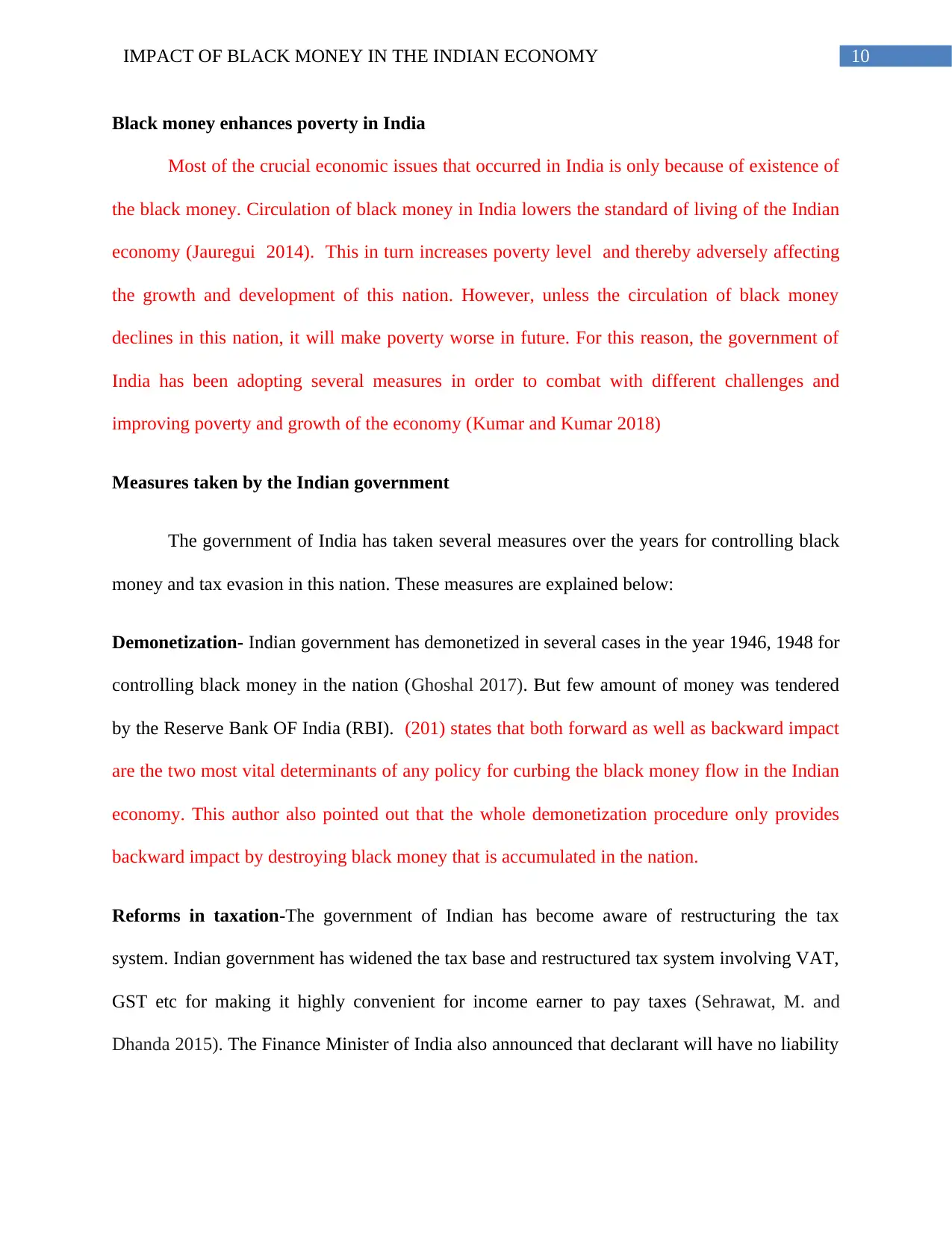
10IMPACT OF BLACK MONEY IN THE INDIAN ECONOMY
Black money enhances poverty in India
Most of the crucial economic issues that occurred in India is only because of existence of
the black money. Circulation of black money in India lowers the standard of living of the Indian
economy (Jauregui 2014). This in turn increases poverty level and thereby adversely affecting
the growth and development of this nation. However, unless the circulation of black money
declines in this nation, it will make poverty worse in future. For this reason, the government of
India has been adopting several measures in order to combat with different challenges and
improving poverty and growth of the economy (Kumar and Kumar 2018)
Measures taken by the Indian government
The government of India has taken several measures over the years for controlling black
money and tax evasion in this nation. These measures are explained below:
Demonetization- Indian government has demonetized in several cases in the year 1946, 1948 for
controlling black money in the nation (Ghoshal 2017). But few amount of money was tendered
by the Reserve Bank OF India (RBI). (201) states that both forward as well as backward impact
are the two most vital determinants of any policy for curbing the black money flow in the Indian
economy. This author also pointed out that the whole demonetization procedure only provides
backward impact by destroying black money that is accumulated in the nation.
Reforms in taxation-The government of Indian has become aware of restructuring the tax
system. Indian government has widened the tax base and restructured tax system involving VAT,
GST etc for making it highly convenient for income earner to pay taxes (Sehrawat, M. and
Dhanda 2015). The Finance Minister of India also announced that declarant will have no liability
Black money enhances poverty in India
Most of the crucial economic issues that occurred in India is only because of existence of
the black money. Circulation of black money in India lowers the standard of living of the Indian
economy (Jauregui 2014). This in turn increases poverty level and thereby adversely affecting
the growth and development of this nation. However, unless the circulation of black money
declines in this nation, it will make poverty worse in future. For this reason, the government of
India has been adopting several measures in order to combat with different challenges and
improving poverty and growth of the economy (Kumar and Kumar 2018)
Measures taken by the Indian government
The government of India has taken several measures over the years for controlling black
money and tax evasion in this nation. These measures are explained below:
Demonetization- Indian government has demonetized in several cases in the year 1946, 1948 for
controlling black money in the nation (Ghoshal 2017). But few amount of money was tendered
by the Reserve Bank OF India (RBI). (201) states that both forward as well as backward impact
are the two most vital determinants of any policy for curbing the black money flow in the Indian
economy. This author also pointed out that the whole demonetization procedure only provides
backward impact by destroying black money that is accumulated in the nation.
Reforms in taxation-The government of Indian has become aware of restructuring the tax
system. Indian government has widened the tax base and restructured tax system involving VAT,
GST etc for making it highly convenient for income earner to pay taxes (Sehrawat, M. and
Dhanda 2015). The Finance Minister of India also announced that declarant will have no liability

11IMPACT OF BLACK MONEY IN THE INDIAN ECONOMY
in paying interest and hence will be approved immunity from the prosecution under certain acts
including, Income tax, Companies act, Foreign Exchange Regulation act etc(Jauregui 2014).
Special Bearer bonds- These are the bonds that have stated maturity date as well as interest rate
and are mainly intended to canalize unaccounted fund for the productive purposes. In the year
1981 and 1991, the Indian government has introduced Special Bearer bonds for dragging black
money into treasury coffer. It is advocated for unearthing black money but it is being modified
according to prevailing conditions in the economy.
Voluntary Disclosure schemes-The government of India has floated different voluntary
disclosure schemes for curbing black money. The policymakers gave assurance that the total
amount
Bilateral agreement with foreign governments- The Indian government has taken some
measures for entering into bilateral agreements with international nations in order to reveal
account holders name and funds deposited in the foreign banks. The government of this country
has already initiated few steps by revising DTAA (Double taxation Avoidance Agreement) to
give means for the investigation of illegal money in Swiss banks in the year 2010. In addition,
the government of India has also signed TIEA( Tax information Exchange Agreement) with 10
nations in order to curb black money in the economy.
Gaps in Literature review
The present literature review reflects that black money has adversely affected on the
growth of the Indian economy. It also reflects on how the black money in India enhances poverty
level and lowers he growth and development of the Indian economy. The gap in the literature
occurs as the future challenges that India might face regarding black money is not discussed in
in paying interest and hence will be approved immunity from the prosecution under certain acts
including, Income tax, Companies act, Foreign Exchange Regulation act etc(Jauregui 2014).
Special Bearer bonds- These are the bonds that have stated maturity date as well as interest rate
and are mainly intended to canalize unaccounted fund for the productive purposes. In the year
1981 and 1991, the Indian government has introduced Special Bearer bonds for dragging black
money into treasury coffer. It is advocated for unearthing black money but it is being modified
according to prevailing conditions in the economy.
Voluntary Disclosure schemes-The government of India has floated different voluntary
disclosure schemes for curbing black money. The policymakers gave assurance that the total
amount
Bilateral agreement with foreign governments- The Indian government has taken some
measures for entering into bilateral agreements with international nations in order to reveal
account holders name and funds deposited in the foreign banks. The government of this country
has already initiated few steps by revising DTAA (Double taxation Avoidance Agreement) to
give means for the investigation of illegal money in Swiss banks in the year 2010. In addition,
the government of India has also signed TIEA( Tax information Exchange Agreement) with 10
nations in order to curb black money in the economy.
Gaps in Literature review
The present literature review reflects that black money has adversely affected on the
growth of the Indian economy. It also reflects on how the black money in India enhances poverty
level and lowers he growth and development of the Indian economy. The gap in the literature
occurs as the future challenges that India might face regarding black money is not discussed in
⊘ This is a preview!⊘
Do you want full access?
Subscribe today to unlock all pages.

Trusted by 1+ million students worldwide
1 out of 18
Your All-in-One AI-Powered Toolkit for Academic Success.
+13062052269
info@desklib.com
Available 24*7 on WhatsApp / Email
![[object Object]](/_next/static/media/star-bottom.7253800d.svg)
Unlock your academic potential
Copyright © 2020–2026 A2Z Services. All Rights Reserved. Developed and managed by ZUCOL.

